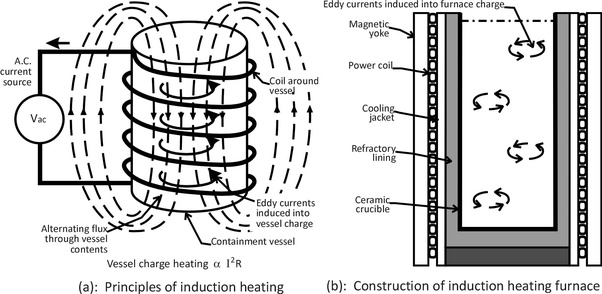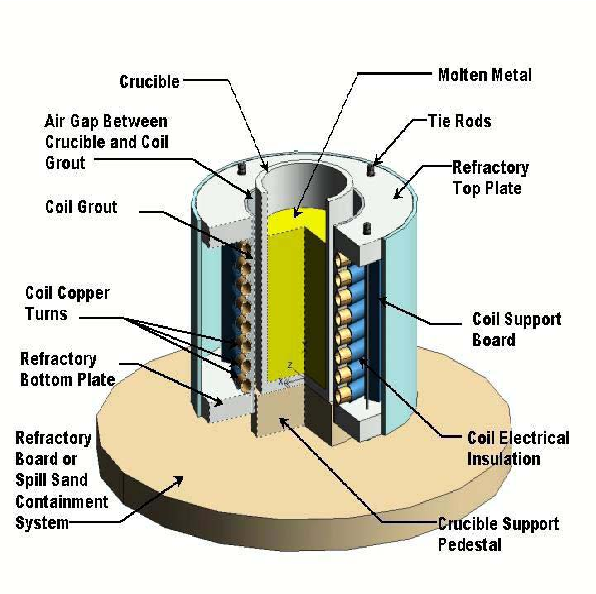AN ISO 9001 : 2008 CERTIFIED CO
AN ISO 9001 : 2008 CERTIFIED CO
The development of Induction Furnace has started with the discovery of the principle of electromagnetic induction by Michael Faraday. However it was not until the late 1870s when De Ferranti, in Europe began experiments on Induction furnaces. The first Induction Furnace for melting metals was patented by Edward Allen Colby around 1900. The first practical usage Induction Furnace of was by Kjellin in Gysinnge, Sweden in 1900. The first steel was made in an Induction Furnace in the United States in 1907 in a Colby furnace near Philadelphia. The first Induction Furnace for 3-phase application was built in Germany in 1906 by Rochling-Rodenhauser.
Principle of Induction Furnace:
The principle of induction heating is mainly based on two well-known physical phenomena:
1. Electromagnetic induction
2. The Joule effect
1) ELECTROMAGNETIC INDUCTION
The energy transfer to the object to be heated occurs by means of electromagnetic induction. Any electrically conductive material placed in a variable magnetic field is the site of induced electric currents, called eddy currents, which will eventually lead to joule heating.

2) JOULE HEATING
Joule heating is the physical effect by which the pass of current through an electrical conductor produces thermal energy. This thermal energy is then evidenced through a rise in the conductor material temperature, thus the term “heating”.One can see Joule heating as a transformation between “electrical engegy” and “thermal energy”, following the energy conservation principal.

(i) Channel Induction Furnace
.png)
The channel Induction Furnace consists of a refractory lined steel shell which contains the molten metal. Attached to the steel shell and connected by a throat is an induction unit which forms the melting component of the furnace. The induction unit consists of an iron core in the form of a ring around which a primary induction coil is wound. This assembly forms a simple transformer in which the molten metal loops comprise the secondary component. The heat generated within the loop causes the metal to circulate into the main well of the furnace. The circulation of the molten metal causes a useful stirring action in the melt. The channel Induction Furnace is normally used for melting low melting point alloys, or as a holding and superheating unit for higher melting point alloys such as cast iron.
(ii) Coreless induction Furnace.

The coreless Induction Furnace has a fairly simple construction. It basically consists of a refractory vessel and the surrounding coil borne by a steel frame. When an alternating current (AC) flows through the coil, it creates an electromagnetic field which in turn induces eddy currents in the charged material. This charge material gets heated up as per Joule’s law and with further heat the charge material melts.
The main component of the coreless Induction Furnace consists of a crucible, a power supply unit consisting of transformer, inverter and capacitor bank, the charging arrangement, the cooling system for the power supply and furnace coil, process control system, and the fume extraction equipment.
Application of Induction Furnace:
1.Investment casting. Induction melting is often used for investment casting because they come in a wide variety of air and vacuum furnaces. These furnaces work great for nearly all metals.
2.Precious metals melting. Steel is precious for many, but induction furnaces can also be used to melt precious metals such as platinum group metals. This allows them to be refined and used for jewelry manufacturing.
3.Copper melting. Induction furnaces can be used to melt custom castings or casting large bronze structures. They’re built to provide the melting you need for most copper applications with low metal loss and precise temperature control.
4.Alloy manufacturing. Induction furnaces are popularly used in alloy manufacturing for optimal uniformity and flexibility. Those in alloy manufacturing companies can count on induction furnaces to provide them with the correct amount of induction stirring each and every time so every product comes out exactly the same.
5.Aluminum melting. Aluminum melting is another popular application used for induction melting. Because induction furnaces are energy efficient, they’re considered optimal for converting alumina into pure aluminum and then into aluminum alloys. This is because this process consumes a lot of energy and so the more energy that can be saved the better.
6.Shrink-fitting.Induction shrink-fitting is used for insertion of one metal part into a second metal part. The second metal part is heated just enough that the metal slightly expands, allowing easy insertion of the first part. Once cooled, the parts cannot be separated without significant force, or by reheating and reversing the process.
7.Brazing.Brazing is a process in which two or more materials are joined together by a filler metal that has a lower melting point than the base materials using Induction heating.
8.Annealing.Annealing is a heat treatment process used mostly to increase the ductility and reduce the hardness of a material. This change in hardness and ductility is a result of the reduction of dislocations in the crystal structure of the material being annealed.